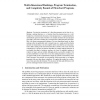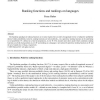FLAIRS
2009
14 years 3 months ago
2009
In this paper, we are interested in the qualitative knowledge that underlies some given probabilistic information. To represent such qualitative structures, we use ordinal conditi...
SAS
2010
Springer
14 years 4 months ago
2010
Springer
Abstract. Proving the termination of a flowchart program can be done by exhibiting a ranking function, i.e., a function from the program states to a wellfounded set, which strictl...
CIKM
2010
Springer
14 years 4 months ago
2010
Springer
Traditional machine-learned ranking algorithms for web search are trained in batch mode, which assume static relevance of documents for a given query. Although such a batch-learni...
SIGIR
2008
ACM
14 years 5 months ago
2008
ACM
Ranking algorithms, whose goal is to appropriately order a set of objects/documents, are an important component of information retrieval systems. Previous work on ranking algorith...
AI
2006
Springer
14 years 5 months ago
2006
Springer
The Spohnian paradigm of ranking functions is in many respects like an order-of-magnitude reverse of subjective probability theory. Unlike probabilities, however, ranking function...
TREC
2003
14 years 7 months ago
2003
Ranking functions are instrumental for the success of an information retrieval (search engine) system. However nearly all existing ranking functions are manually designed based on...
NIPS
2004
14 years 7 months ago
2004
The area under the ROC curve (AUC) has been advocated as an evaluation criterion for the bipartite ranking problem. We study large deviation properties of the AUC; in particular, ...
CIKM
2008
Springer
14 years 7 months ago
2008
Springer
Learning-to-rank algorithms, which can automatically adapt ranking functions in web search, require a large volume of training data. A traditional way of generating training examp...
CIKM
2008
Springer
14 years 7 months ago
2008
Springer
Machine Learned Ranking approaches have shown successes in web search engines. With the increasing demands on developing effective ranking functions for different search domains, ...
CIKM
2009
Springer
14 years 9 months ago
2009
Springer
Feature weighting or selection is a crucial process to identify an important subset of features from a data set. Removing irrelevant or redundant features can improve the generali...







